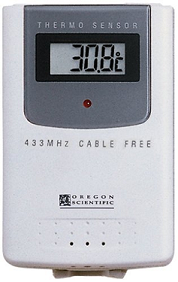




Oregon THN128 433MHz temperature transmit/receive library for Arduino
This is a 433MHz wireless 3-channel Oregon THN128 temperature transmit/receive Arduino library for ATMega328, ESP8266 and ESP32 using the (reverse-engineered) Oregon THN128 v1 protocol:

Transmit / receive hardware
This Arduino library can be used with low-power ATMega328 microcontroller (AVR architectures like Arduino UNO and Pro Mini 3.3V 8MHz boards).

Temperature transmitter on the left breadboard:
- Pro-Mini 3V3 8MHz.
- Genuine DS18B20 temperature sensor.
- STX802 low-power 433MHz transmitter.
Receiver on the right breadboard:
- SRX882 low-power 433MHz receiver.
- SSD1306 I2C 128x64 OLED display.
- Pro-Mini 3V3 8MHz.
Supported microcontrollers
- ATMega328 AVR designed for low-power
- ESP8266
- ESP32
- Other microcontrollers are not tested and may or may not work
Arduino Examples
ESP32 with MQTT and Homeassistant
The Erriez_Oregon_THN128_ESP32_MQTT_Homeassistant.ino sketch can be used with Homeassistant integration.
Example screenshot Homeassistant dasboard:

Follow the steps below:
- Configure Homeassistant MQTT in
configuration.yaml:
mqtt:
discovery_prefix: ha
# Enable when using SSL:
# certificate: /ssl/ca.crt
# client_cert: /ssl/client.crt
# client_key: /ssl/client.key
- MQTT broker hostname, username and password should be configured in
Homeassistant | Settings | Devices | MQTT.
- Configure the listed macro's in the example, build and run from the Arduino IDE. The following Oregon THN128 entities are automatically registered after a succesful MQTT connection:
- sensor.oregon_thn128_ch1
- sensor.oregon_thn128_ch2
- sensor.oregon_thn128_ch3
- sensor.oregon_thn128_battery
- Configure Homeassistant dashboard configuration file:
Hardware Design Notes
Supported hardware:
- AVR designed for low-power
- ESP8266
- ESP32
- For low-power transmitters, a
Pro Mini 3V3 8MHz bare board with ATMega328 microcontroller is highly recommended. The board has no serial interface chip which reduces continuous power consumption. An external FTDI232 - USB serial interface should be connected for serial console / programming. (See red PCB on the picture) The SMD power LED should be desoldered from the Pro Mini to reduce continuous power consumption.
- A transmitter with (protected) 1500mA 18650 battery can operate for at least 6 months with
LowPower.h functionality implemented. (By sending the temperature every 30 seconds)
- Changing the BOD (Brown Out Detection) fuse to 1.8V allows operation between 1.8 and 4.2V 18650 battery. (Explanation beyond the scope of this project)
- 1 to 3 temperature transmitters are supported, similar to the original Oregon THN128 temperature transmitters.
- Check list of counterfeit DS18B20 chips , because this makes a huge difference in accuracy and read errors at 3.3V. Many DS18B20 chips from Aliexpress are counterfeit and won't work
reliable at voltages below 3.3V.
- NiceRF Wireless Technology Co., Ltd. sells high quality 433MHz transmit (STX802) and receiver modules (STX882) with a good range.
- A 18650 battery (with protection circuit) should be connected directly to the VCC pin (not VIN).
- The voltage regulator can be desoldered from the pro-micro board when not used for more power reduction.
Oregon Protocol
A packet is sent twice:

Data (see header file ErriezOregonTHN128Receive.h):
- Byte 0:
- Bit 0..3: Rolling address (Random value after power cycle)
- Bit 6..7: Channel: (0 = channel 1 .. 2 = channel 3)
- Byte 1:
- Bit 0..3: TH3
- Bit 4..7: TH2
- Byte 2:
- Bit 0..3: TH1
- Bit 5: Sign
- Bit 7: Low battery
- Byte 3:

Library Changes
v1.1.0
The callback function void delay100ms() has been removed as this was not compatible with ESP32. The application should change the code to:
{c++}
// Send temperature twice with 100ms delay between packets
OregonTHN128_Transmit(&data);
delay(100);
OregonTHN128_Transmit(&data);
AVR targets can replace delay(100) with LowPower usage:
{c++}
LowPower.powerDown(SLEEP_15MS, ADC_OFF, BOD_OFF);
LowPower.powerDown(SLEEP_60MS, ADC_OFF, BOD_OFF);
LowPower.powerDown(SLEEP_15MS, ADC_OFF, BOD_OFF);
Saleae Logic Analyzer

capture from the Oregon THN128 can be opened with https://www.saleae.com/downloads/.
Generated Arduino Library Doxygen Documentation
MIT License
This project is published under MIT license with an additional end user agreement (next section).
End User Agreement :ukraine:
End users shall accept the End User Agreement holding export restrictions to Russia to stop the WAR before using this project.







